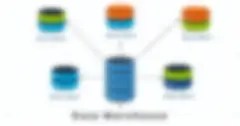Kinh Nghiệm Hướng dẫn 4 the logical view of a database is presents data as they would be perceived by end users Chi Tiết
Bạn đang tìm kiếm từ khóa 4 the logical view of a database is presents data as they would be perceived by end users được Update vào lúc : 2022-10-27 19:00:10 . Với phương châm chia sẻ Bí kíp về trong nội dung bài viết một cách Chi Tiết Mới Nhất. Nếu sau khi Read Post vẫn ko hiểu thì hoàn toàn có thể lại phản hồi ở cuối bài để Mình lý giải và hướng dẫn lại nha.
In a market dominated by big data and analytics, data marts are one key to efficiently transforming information into insights. Data warehouses typically giảm giá with large data sets, but data analysis requires
easy-to-find and readily available data. Should a business person have to perform complex queries just to access the data they need for their reports? No—and that’s why companies smart companies use data marts.
Nội dung chính Show
- Data Mart vs Data Warehouse
- 3 Types of
Data Marts - Structure of a Data Mart
- Advantages of a Data Mart
- The Future of Data Marts is in the Cloud
- Getting Started With Data Marts
- What is the logical view of a database?
- Which view of a database presents the view that the end users have?
- What is logically related data in database?
- What is logical and physical view in database?
A data mart is a subject-oriented database that is often a partitioned segment of an enterprise data warehouse. The subset of data held in a data mart typically aligns with a particular business unit like sales, finance, or marketing. Data marts accelerate business processes by
allowing access to relevant information in a data warehouse or operational data store within days, as opposed to months or longer. Because a data mart only contains the data applicable to a certain business area, it is a cost-effective way to gain actionable insights quickly.
Data Mart vs Data Warehouse
Data marts and data warehouses are both highly structured repositories where data is stored and managed until it is needed. However, they differ in the scope of data stored: data
warehouses are built to serve as the central store of data for the entire business, whereas a data mart fulfills the request of a specific division or business function. Because a data warehouse contains data for the entire company, it is best practice to have strictly control who can access it. Additionally, querying the data you need in a data warehouse is an incredibly difficult task for the business. Thus, the primary purpose of a data mart is to isolate—or partition—a smaller set of data
from a whole to provide easier data access for the end consumers.


A data mart can be created from an existing data warehouse—the top-down approach—or from other sources, such as internal operational systems or external data.
Similar to a data warehouse, it is a relational database that stores transactional data (time value, numerical order, reference to one or more object) in columns and rows making it easy to organize and access.
On the other hand, separate business units may create their own data marts based on their own data requirements. If business needs dictate, multiple data marts can be merged together to create a single, data warehouse. This is the bottom-up development approach.
3 Types of
Data Marts
There are three types of data marts: dependent, independent, and hybrid. They are categorized based on their relation to the data warehouse and the data sources that are used to create the system.
1. Dependent Data Marts
A dependent data mart is created from an existing enterprise data warehouse. It is the top-down approach that begins with storing all business data in one central location, then extracts a clearly defined portion of the data when needed for
analysis.
To form a data warehouse, a specific set of data is aggregated (formed into a cluster) from the warehouse, restructured, then loaded to the data mart where it can be queried. It can be a logical view or physical subset of the data warehouse:
- Logical view – A virtual table/view that is logically—but not physically—separated from the data warehouse
- Physical subset – Data extract that is a physically separate database from the data
warehouse
Granular data—the lowest level of data in the target set—in the data warehouse serves as the single point of reference for all dependent data marts that are created.
2. Independent Data Marts
An independent data mart is a stand-alone system—created without the use of a data warehouse—that focuses on one subject area or business function. Data is extracted from internal or external data sources (or both), processed, then loaded to the data mart repository
where it is stored until needed for business analytics.
Independent data marts are not difficult to design and develop. They are beneficial to achieve short-term goals but may become cumbersome to manage—each with its own ETL tool and logic—as business needs expand and become more complex.
3. Hybrid Data Marts
A hybrid data mart combines data from an existing data warehouse and other
operational source systems. It unites the speed and end-user focus of a top-down approach with the benefits of the enterprise-level integration of the bottom-up method.
Structure of a Data Mart
Similar to a data warehouse, a data mart may be organized using a star, snowflake, vault, or other schema as a blueprint. IT teams typically use a star schema consisting of one or more fact tables (set of metrics relating to a specific business process or sự kiện) referencing dimension tables (primary key joined to a fact table) in a relational database.
The benefit of a star schema is that fewer joins are needed when writing queries, as there is no dependency between dimensions. This simplifies
the ETL request process making it easier for analysts to access and navigate.
In a snowflake schema, dimensions are not clearly defined. They are normalized to help reduce data redundancy and protect data integrity. It takes less space to store dimension tables, but it is a more complicated structure (multiple tables to
populate and synchronize) that can be difficult to maintain.
Advantages of a Data Mart
Managing big data—and gaining valuable business insights—is a challenge all companies face, and one that most are answering with strategic data marts.
- Efficient access — A data mart is a time-saving solution for accessing a specific set of data for business intelligence.
- Inexpensive data warehouse alternative — Data marts can be an inexpensive alternative to
developing an enterprise data warehouse, where required data sets are smaller. An independent data mart can be up and running in a week or less. - Improve data warehouse performance — Dependent and hybrid data marts can improve the performance of a data warehouse by taking on the burden of processing, to meet the needs of the analyst. When dependent data marts are placed in a separate processing facility, they significantly reduce analytics processing costs as well.
Other
advantages of a data mart include:
- Data maintenance — Different departments can own and control their data.
- Simple setup — The simple design requires less technical skill to set up.
- Analytics — Key performance indicators (KPIs) can be easily tracked.
- Easy entry — Data marts can be the building blocks of a future enterprise data warehouse project.
The Future of Data Marts is in the Cloud
Even with the improved
flexibility and efficiency that data marts offer, big data—and big business—is still becoming too big for many on-premises solutions. As data warehouses and data lakes move to the cloud, so too do data marts.
With a shared cloud-based platform to create and house data, access and analytics become much more efficient. Transient data clusters can be created for short-term analysis, or long-lived clusters can come together for more sustained work. Modern technologies are also separating data storage from compute, allowing for ultimate scalability for querying data.
Other advantages of cloud-based dependent and hybrid data marts include:
- Flexible architecture with
cloud-native applications. - Single depository containing all data marts.
- Resources consumed on-demand.
- Immediate real-time access to information.
- Increased efficiency.
- Consolidation of resources that lowers costs.
- Real-time, interactive analytics.
Getting Started With Data Marts
Companies are faced with an endless amount of information and an ever-changing need to parse that information into manageable chunks for analytics and
insights. Data marts in the cloud provide a long-term, scalable solution. To create a data mart, be sure to find an ETL tool that will allow you to connect to your existing data warehouse or other essential data sources that your business users need to draw insights from. In addition, make sure that your data integration tool can regularly update the data mart to ensure that your data—and the resulting analytics—are up-to-date.
Talend Data Management Platform helps teams work smarter with an open, scalable architecture and simple, graphical tools to help transform and load applicable data sources to create a new data mart. Additionally, Talend Data Management Platform simplifies maintaining existing data marts by automating and scheduling integration jobs needed to update the data mart.
With
Talend Open Studio for Data Integration, you can connect to technologies like Amazon Web Services Redshift, Snowflake, and Azure Data Warehouse to create your own data marts, leveraging the flexibility and scalability of the cloud.
What is the logical view of a database?
The logical database view is how the data appear to the user to be stored. This view represents the structure that the user must interface with in order to extract data from the database.
Which view of a database presents the view that the end users have?
The logical view presents data as they would be perceived by end users or business specialists, whereas the physical view shows how data are actually organized and structured on physical storage truyền thông.
What is logically related data in database?
Logically related data means that the data should be relevant in some context. Example: If we are going to make a database for a customer then the database may include customer name, contact number, age, past orders, address, email id, etc. All these information are in the context of the customer.
What is logical and physical view in database?
Physical view refers to the way data are physically stored and processed in a database. On the other side, logical view is designed to suit the need of different users by representing data in a meaningful format. Another word, the logical view tells the users, in their term, what is in the database.
Tải thêm tài liệu liên quan đến nội dung bài viết 4 the logical view of a database is presents data as they would be perceived by end users




Share Link Cập nhật 4 the logical view of a database is presents data as they would be perceived by end users miễn phí
Bạn vừa Read tài liệu Với Một số hướng dẫn một cách rõ ràng hơn về Review 4 the logical view of a database is presents data as they would be perceived by end users tiên tiến và phát triển nhất và Share Link Down 4 the logical view of a database is presents data as they would be perceived by end users miễn phí.

Hỏi đáp vướng mắc về 4 the logical view of a database is presents data as they would be perceived by end users
Nếu sau khi đọc nội dung bài viết 4 the logical view of a database is presents data as they would be perceived by end users vẫn chưa hiểu thì hoàn toàn có thể lại Comments ở cuối bài để Ad lý giải và hướng dẫn lại nha
#logical #view #database #presents #data #perceived #users